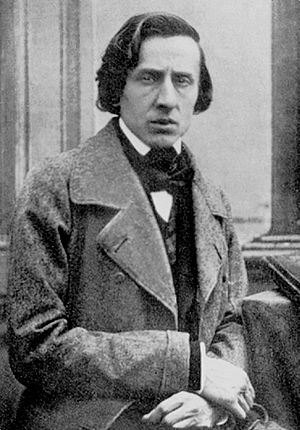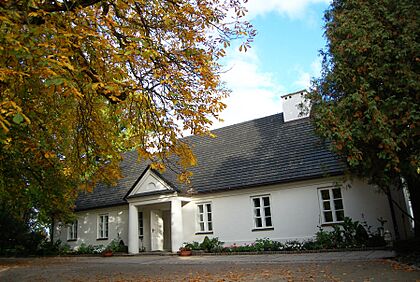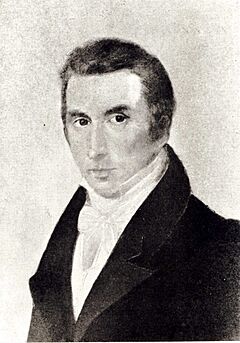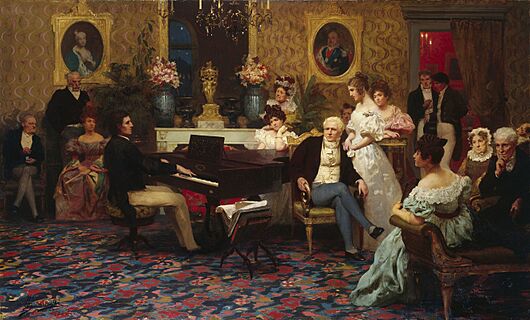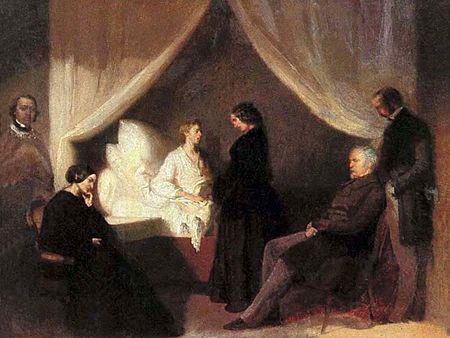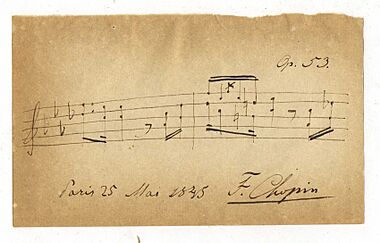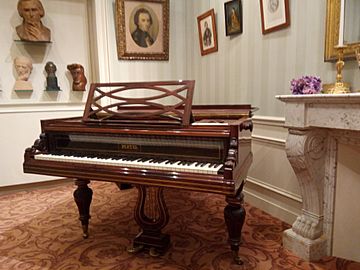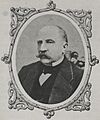Frédéric Chopin facts for kids
Frédéric François Chopin (born Fryderyk Franciszek Chopin; 1 March 1810 – 17 October 1849) was a Polish composer and a brilliant pianist from the Romantic period. He is considered one of the greatest composers for the piano. His music is known for being beautiful, emotional, and creative.
Chopin was born near Warsaw, Poland. He was a child prodigy, meaning he had amazing musical talent from a very young age. After finishing his music studies in Warsaw, he moved to Paris, France, at the age of 21. He lived there for the rest of his life.
In Paris, Chopin became famous as a composer and piano teacher. He preferred playing in small, private gatherings called salons rather than in large concert halls. He was friends with other famous musicians of his time, like Franz Liszt. He also had a long and important friendship with the French writer George Sand.
Almost all of Chopin's music is for the solo piano. He wrote many different kinds of pieces, including mazurkas, waltzes, nocturnes, polonaises, études, and sonatas. His music was often inspired by Polish folk music and his love for his homeland. Chopin's health was poor for most of his life, and he died in Paris at the age of 39. His work remains very popular and is played by pianists all over the world.
Contents
Life
A Musical Genius in Poland
Frédéric Chopin was born in the village of Żelazowa Wola, Poland. His father, Nicolas Chopin, was a Frenchman who had moved to Poland, and his mother, Justyna, was Polish. He had three sisters. A few months after he was born, his family moved to Warsaw, the capital of Poland.
His family was very musical. His father played the flute and violin, and his mother played the piano and taught lessons. Chopin started learning piano from his mother. It was clear very early on that he was a child prodigy. By age seven, he was already performing in public concerts and composing his own music. His first professional piano teacher was Wojciech Żywny, who quickly realized his young student was a genius.
From 1823 to 1826, Chopin studied at the Warsaw Lyceum, a top school. Then, he studied music at the Warsaw Conservatory under the composer Józef Elsner. Elsner recognized Chopin's unique talent and let him develop his own style. During this time, Chopin wrote some of his first major works, including two piano concertos.
During his school vacations, Chopin often traveled to the countryside. There, he heard Polish folk music for the first time. The rhythms and melodies of this music would later become a big inspiration for his own compositions, especially his mazurkas.
Moving to Paris
In 1830, at the age of 20, Chopin left Poland to travel and build his career in Western Europe. Shortly after he left, a big rebellion against Russian rule, known as the November Uprising, broke out in Warsaw. Because of the fighting, Chopin could not return home. He was very sad about this and missed Poland for the rest of his life.
He decided to settle in Paris in 1831. At the time, Paris was a center of art and culture, and many famous artists, writers, and musicians lived there. Chopin quickly made friends with important figures like the composer Franz Liszt. Liszt and Chopin admired each other's talent and sometimes performed together.
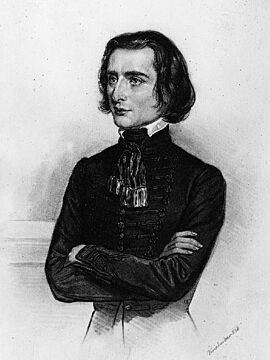
Chopin became famous in Paris, but not by playing in huge concerts. He was a master of playing in salons, which were gatherings in the homes of wealthy people. In these smaller spaces, his delicate and expressive playing could be heard perfectly. He earned a good living by selling his compositions and giving piano lessons to wealthy students.
During his early years in Paris, he fell in love with a young Polish woman named Maria Wodzińska. He proposed to her in 1836, but her family did not approve of the marriage, partly because of his poor health. Chopin was heartbroken by this.
Friendship with George Sand
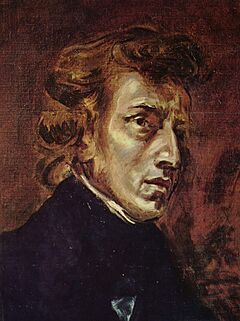
In 1836, Chopin met the famous French writer Amantine Dupin, who was known by her male pen name, George Sand. They became very close friends, and their relationship was one of the most important in his life. They spent nine years together.
In the winter of 1838–39, Chopin, Sand, and her children traveled to the Spanish island of Mallorca. They hoped the warmer weather would help Chopin's health. However, the winter was cold and rainy, and Chopin became very sick. Despite this, it was a very creative time for him. He completed one of his most famous sets of pieces, the 24 Preludes, Op. 28.
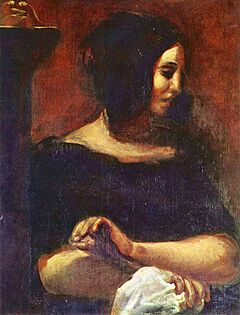
For many years, Chopin spent his summers at George Sand's country house in Nohant, France. These were peaceful and happy times for him. He composed many of his greatest works there, including the famous "Heroic" Polonaise. After nearly a decade, their friendship ended in 1847, and they went their separate ways.
Final Years
From 1842 onward, Chopin's health grew much worse. He composed less music than before, but the pieces he did write were some of his most thoughtful and complex.
In 1848, he traveled to London, England, at the invitation of his Scottish student, Jane Stirling. He gave several concerts and played for Queen Victoria. He then traveled to Scotland but the damp weather made his health even worse.
He gave his last public performance in London in November 1848 at a benefit for Polish refugees. By then, he was extremely weak. He returned to Paris a short time later.
Death and Legacy
Chopin passed away in Paris on 17 October 1849, at the age of 39. The cause of his death was likely tuberculosis. His sister, Ludwika, and his closest friends were with him when he died.
His funeral was held at the Church of the Madeleine in Paris. Over 3,000 people came to pay their respects. As he had wished, Mozart's Requiem was performed. He was buried in the famous Père Lachaise Cemetery in Paris.
Chopin never forgot his homeland. Before he died, he asked that his heart be taken back to Poland. His sister Ludwika fulfilled his wish. His heart was sealed inside a pillar at the Holy Cross Church in Warsaw, where it remains today. It is a symbol of his great love for Poland.
Chopin's Music
A Unique Style
Chopin wrote over 230 musical works, and nearly all of them feature the piano. He was a specialist who focused on creating music that showed off the piano's expressive power. His music is known for its beautiful melodies and rich harmonies.
He wrote music in many different forms, often based on Polish dances:
- Mazurkas: These are based on a traditional Polish folk dance. Chopin wrote over 50 mazurkas that were full of Polish spirit.
- Polonaises: These are based on a stately and grand Polish dance. His polonaises are often powerful and patriotic.
- Waltzes: Unlike waltzes for dancing, Chopin's waltzes were meant for listening and are often brilliant and elegant. The famous "Minute Waltz" is one of them.
- Nocturnes: The word "nocturne" means "night piece." These are slow, dreamy, and lyrical pieces.
- Études: The word "étude" means "study." Each of his études was designed to help pianists practice a specific technical skill, but they are also beautiful pieces of music. His "Revolutionary Étude" is one of his most famous.
- Ballades and Scherzos: These are larger, more dramatic pieces that tell a story through music.
A Master Pianist
Chopin was not only a great composer but also a legendary pianist. His playing style was very unique. It was known for being delicate, sensitive, and full of feeling. He could create a beautiful singing tone on the piano.
He often used a technique called tempo rubato, which means "robbed time." This is when the player slightly speeds up or slows down the music to make it more expressive and emotional, without changing the overall beat.
Chopin preferred playing on pianos made by the French company Pleyel. He loved their soft and rich sound, which was perfect for his intimate and poetic style of music. His ideas about piano playing and his compositions changed how people thought about the instrument forever.
Frédéric Chopin quotes
- "A well formed technique, it seems to me, [is one] that can control and vary a beautiful sound quality."
- "Time is still the best critic, and patience the best teacher."
- "Simplicity is the final achievement. After one has played a vast quantity of notes and more notes, it is simplicity that emerges as the crowning reward of art."
- "Fingers of steel. Wrist of silk."
- "I'm a revolutionary, money means nothing to me."
- "Concerts are never real music, you have to give up the idea of hearing in them all the most beautiful things of art."
Interesting facts about Frédéric Chopin
- Chopin feared being buried alive. On his deathbed in Paris, he requested that his heart be removed after he died. His sister smuggled it back to Poland, where it is now preserved in a pillar at the Holy Cross Church in Warsaw.
- He was composing and playing piano so well by the age of 7 that he was already being compared to Mozart. His first published composition came when he was just 15.
- Despite being one of the most famous pianists of his era, Chopin was extremely shy and disliked the large concert hall atmosphere.
- His popular "Waltz in D-flat Major," Op. 64, No. 1, is nicknamed the "Minute Waltz," but it typically takes about 1.5 to 2 minutes to play. The nickname is believed to mean a "small" or "miniature" waltz, not one that lasts 60 seconds.
- Although he lived in Paris for most of his adult life, Chopin was fiercely patriotic towards his native Poland.
Images for kids
See also
 In Spanish: Frédéric Chopin para niños
In Spanish: Frédéric Chopin para niños
- International Chopin Piano Competition
- The 1st International Chopin Competition on Period Instruments
- Memorials to Frédéric Chopin


